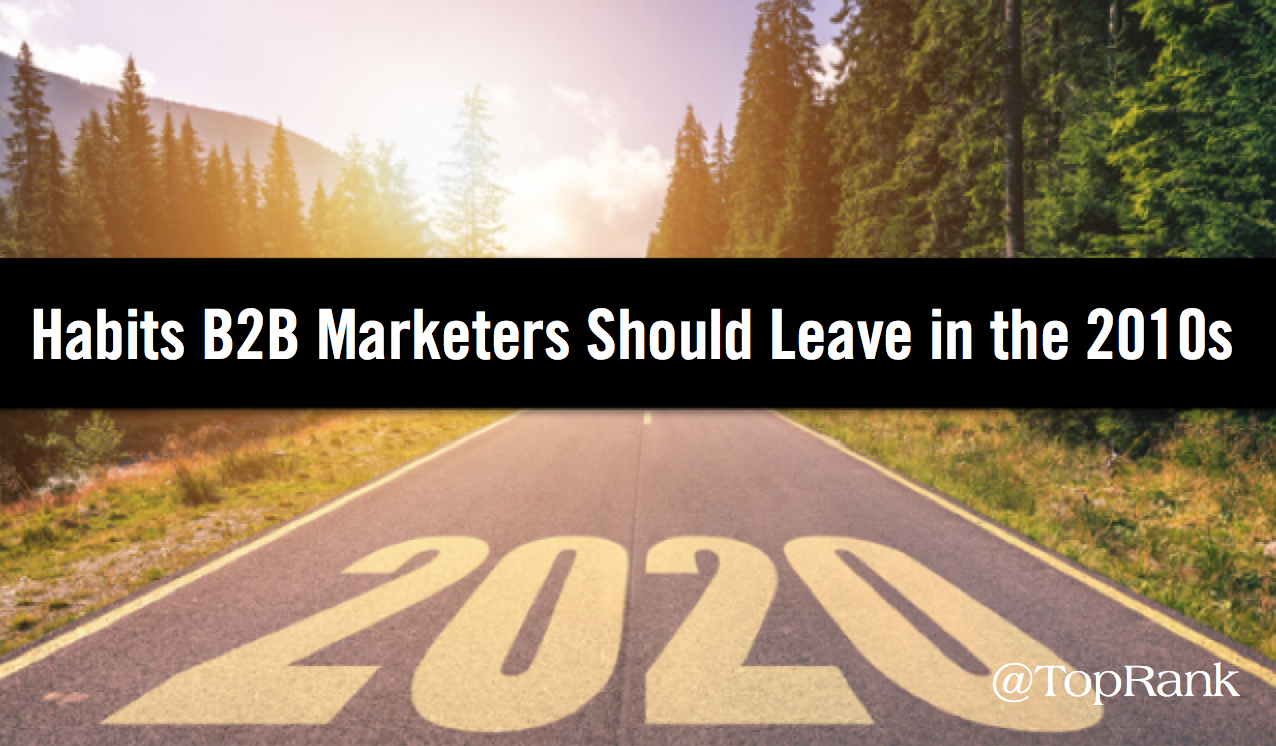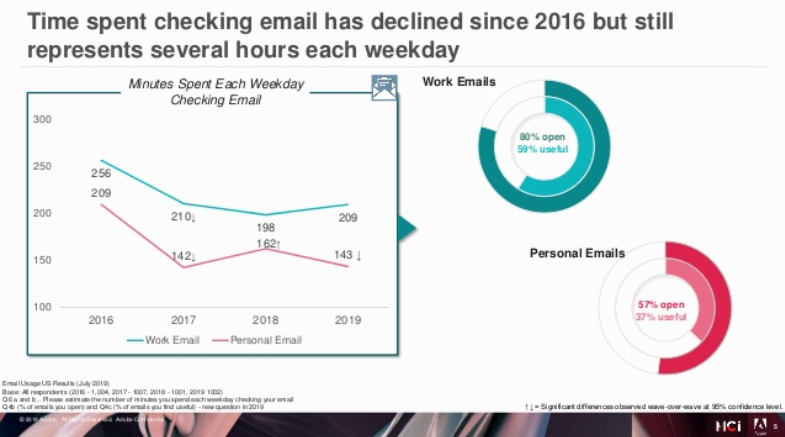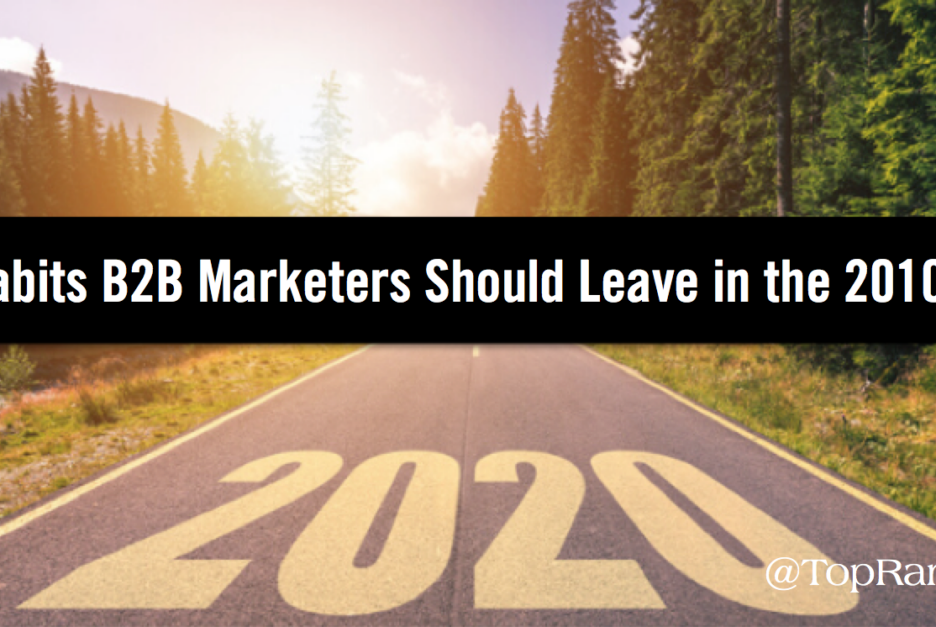
New decade, who dis?
We’ve officially turned the calendar to 201… er, 2020! First the first time in 10 years, we’ll all be writing a different numeral as that third digit. That’s a new habit that’ll take some getting used to.
As B2B marketers, perhaps we can take advantage of this opportunity to form a few other new habits. Specifically, I’m talking about making adjustments to the way we approach our craft, so to align ourselves with the evolved marketplace of the 2020s.
The New Year is always a fitting time for resolutions and aspirational goal-setting. With this particularly momentous milestone, I’m urging all my B2B marketing peers to think big and commit to some major shifts in mindset for the decade ahead.
These five habits ought to be left in the 2010s along with fidget spinners and the Mannequin Challenge.
5 Habits for B2B Marketers to Leave Behind in the 2010s
#1. The Desktop Mentality
Chances are, you spend your days creating content or managing campaigns on a desktop computer or laptop. As such, it’s all too easy to assume your audience will consume it in the same way. But, chances are, they won’t.
The explosion of mobile usage has been among the most unmistakable sea changes of the past decade. In 2010, the iPhone was still a relatively new product and mobile accounted for 2.9% of all web site traffic. By 2018, that figure was up to 52.2%. Smartphone ownership rose from 35% in 2011 to 81% in 2019. Mobile overtook desktop in 2016 and there’s been no looking back.
Despite this, I still routinely encounter websites, landing pages, and content experiences that look great on desktop and clunky on a smartphone or tablet. Too often, mobile is an afterthought. Instead, it should be our first thought. Bringing a mobile-first mindset into the 2020s will position marketers to be on the same page as the people they’re trying to reach.
What To Do: Scrutinize your most critical existing content assets — visuals, responsiveness, usability — on multiple different types of devices to ensure you’re delivering a quality mobile experience. Also, resolve to test all new content on mobile before desktop in 2020.
#2. Aimless Creation
At the start of the decade, content marketing was in a relatively nascent stage. The primary objective for marketers was simply to produce, as reflected by the first-ever B2B content marketing benchmark report from newly established Content Marketing Institute (CMI) in 2010. In this report, the top-cited challenges were:
- Producing engaging content
- Producing enough content
- Budget to produce content
All that production, so little direction… It’s a problem that hasn’t gone away despite content marketing’s maturation over the course of a decade. In general, there’s still too much focus on the creation and not enough on the strategy. In many programs, promotion and measurement take distant back seats.
In the 2020s, let’s start looking at the big picture, and channel the same enthusiasm we show for creation into all the other elements of successful content. A holistic approach to the discipline begins with documenting your content strategy and adhering to its vision, as will a robust list of content promotion tactics to draw from.
In the 2020s, let’s start looking at the big picture, and channel the same enthusiasm we show for creation into all the other elements of successful content. @NickNelsonMN Click To TweetWhat To Do: Create or refine your documented content strategy. Take a gander at our top B2B content marketing trends and predictions for 2020 to ensure you’re fully up to speed.
#3. Email Abandonment
It’s been an interesting decade for email marketing. The tactic’s popularity endures – email newsletters were cited as the third-most common type of content for B2B marketers in the latest CMI benchmarking report – but confidence in this channel has evidently waned.
According to research by the Data & Marketing Association (DMA), only 55% of marketers believe more than half of what they send out is useful to subscribers, and more concerningly, only 14% of subscribers feel that way.
I’m on record as saying email marketing is not dead, it just needs rejuvenation. I think the inbox will be in again in the 2020s, as practitioners get back into touch with the fundamentals that make it such a powerful communication channel to begin with. Through stronger segmentation, audience insight, and relationship-driven strategy, we can get back to capitalizing on a space where the average professional spends 3+ hours of their workday.

(Source)
What To Do: Subscribe to a few newsletters from leading brands to do some recon, and adopt the subscriber-centric practices you like best.
#4. Influence for the Sake of Influence
I wonder if we’ll all look back at the 2017 Fyre Festival fiasco – and the documentaries it yielded – as a turning point for influencer marketing.
In a way, that whole ordeal was damaging, casting a light on the total fraudulence of paid Instagram celebrities hawking products they had no connection to, or understanding of, merely to seem hip and raise awareness. But I view it as more of a positive: That seedy side of “influencer marketing” needed to be exposed, enabling us all to acknowledge it and move past it.
Fyre Festival didn’t prove that influencer marketing is ineffective; it proved that prioritizing reach and status above all else is the wrong way to do it. At TopRank Marketing, we have long asserted that relying on popularity metrics alone is a mistake, while aligning influencer type and topic is critical.
Fyre Festival didn’t prove that influencer marketing is ineffective; it proved that prioritizing reach and status above all else is the wrong way to do it. @NickNelsonMN Click To TweetLinkedIn’s* Judy Tian recently shared her views on this essential nuance: “Even though I think reach is part of the equation, and we want to work with influencers who have a substantial amount of reach … the relevancy and engagement are what’s important. Are the influencers actually experts in the areas you wanna talk about? And are they gonna have credibility with their end users? And then are they going to shed credibility onto your brand as a result?”
These are the true objectives of B2B influencer marketing. It’s influence with a purpose. And that mindset should drive our strategies in the years ahead.
What To Do: Review influencer lists to make sure expertise and credibility aligns with the audience for your campaigns, and start prioritizing relevance over reach for future initiatives.
#5. Talking About Ourselves
I’ll close with perhaps the single most important shift for B2B marketers in 2020 and beyond: Moving the spotlight from our own products and services to our customers. This is a crucial area where data tells us we’re coming up short.
A recent report from Forrester, titled Customer-Centered Messaging Helps Boost B2B Revenues By Motivating Buyer Action, shows that:
- 88% of B2B marketers admit their homepages talk primarily about their companies, products, and services
- 13% of B2B marketers use narrative to tell a story, walk buyers through a persuasive argument, or show some empathy with customer concerns
- 28% of B2B marketers mirror the language that their target audiences and decision makers use when talking about those problems
These are troubling numbers. In the 2020s, we need to take the next step in customer-centricity, going beyond connecting our solutions to the audience by doing so from their point of view. It’s not an easy thing to master – as the Forrester report indicates – but it is a very worthy pursuit.
We should all be striving to develop empathy, as it’s defined by Intuit’s Brian Hood: “Having such a strong understanding that it’s hard to tell the line between us and our customers.” And our content should convey it.
What To Do: Walk the walk when it comes to being customer-centric. Put customer insight in the driver’s seat for everything you create in 2020. Be cognizant of how often you’re centering the conversation on your brand and its solutions.
Here’s to a Decade of Dazzling Results
The next 10 years are going to be exciting and invigorating. Technology, creativity, and data-driven insight will commingle in new ways to reinvent what is possible for digital customer experiences. We’re excited to venture into this great unknown alongside all of our clients, partners, and peers.
From my view, B2B marketers who are best-prepared for what lies ahead will be:
- Mobile-first
- Thoroughly strategic with creation
- Adamant about energizing email engagement
- Focused on influencer relevance
- Keenly customer-centered in approach
Want to further ready yourself for the year and decade ahead? Check out our robust pieces on 2020 trends and predictions:
- 10 Top B2B Influencer Marketing Predictions for 2020
- Our Top B2B Content Marketing Trends & Predictions for 2020
- 13 Top B2B Social Media Marketing Trends & Predictions for 2020
- 10 Top B2B SEO Trends & Predictions for 2020
*Disclosure: LinkedIn is a TopRank Marketing client.



